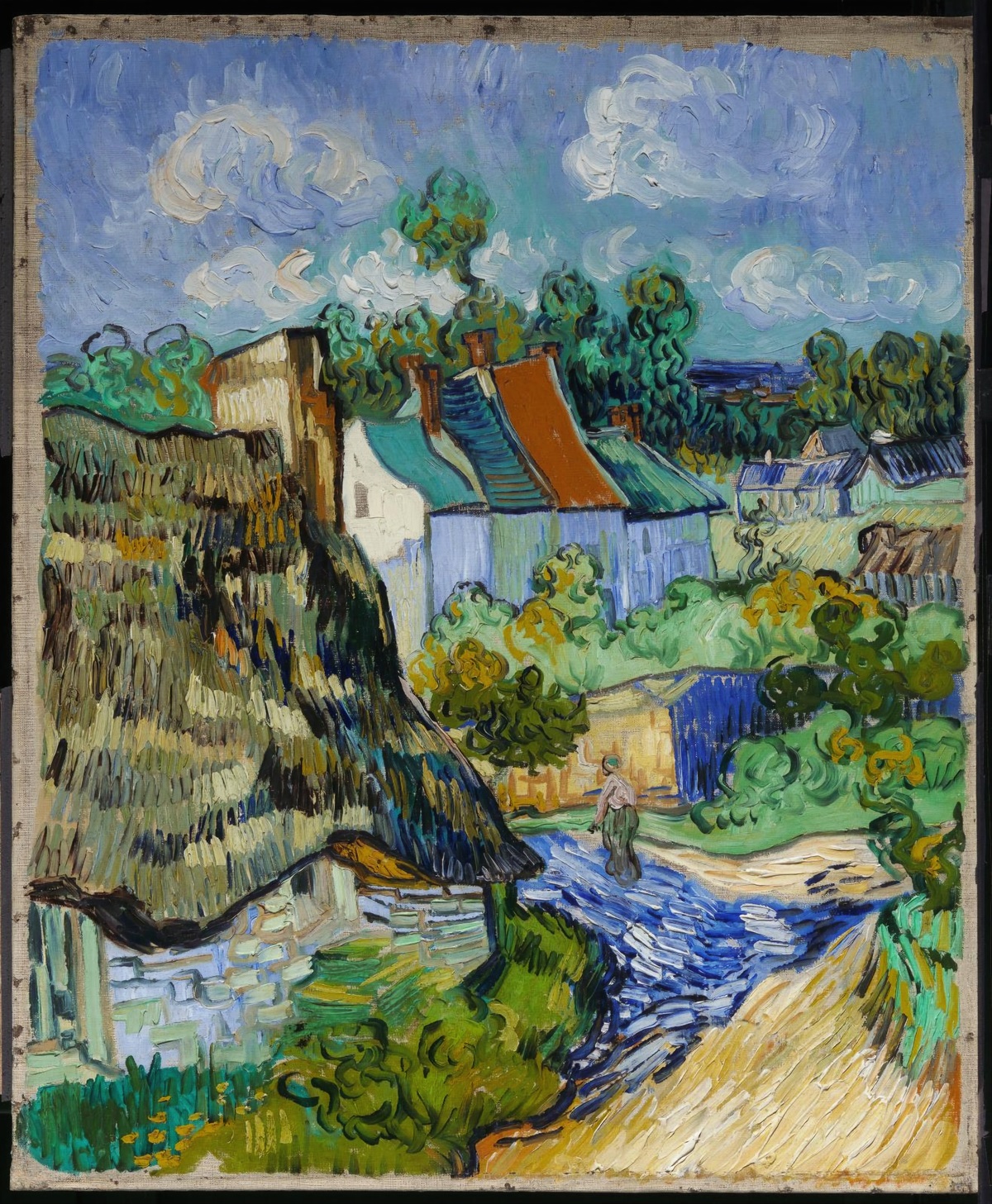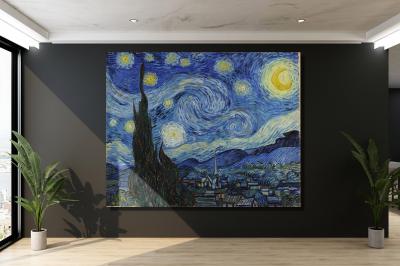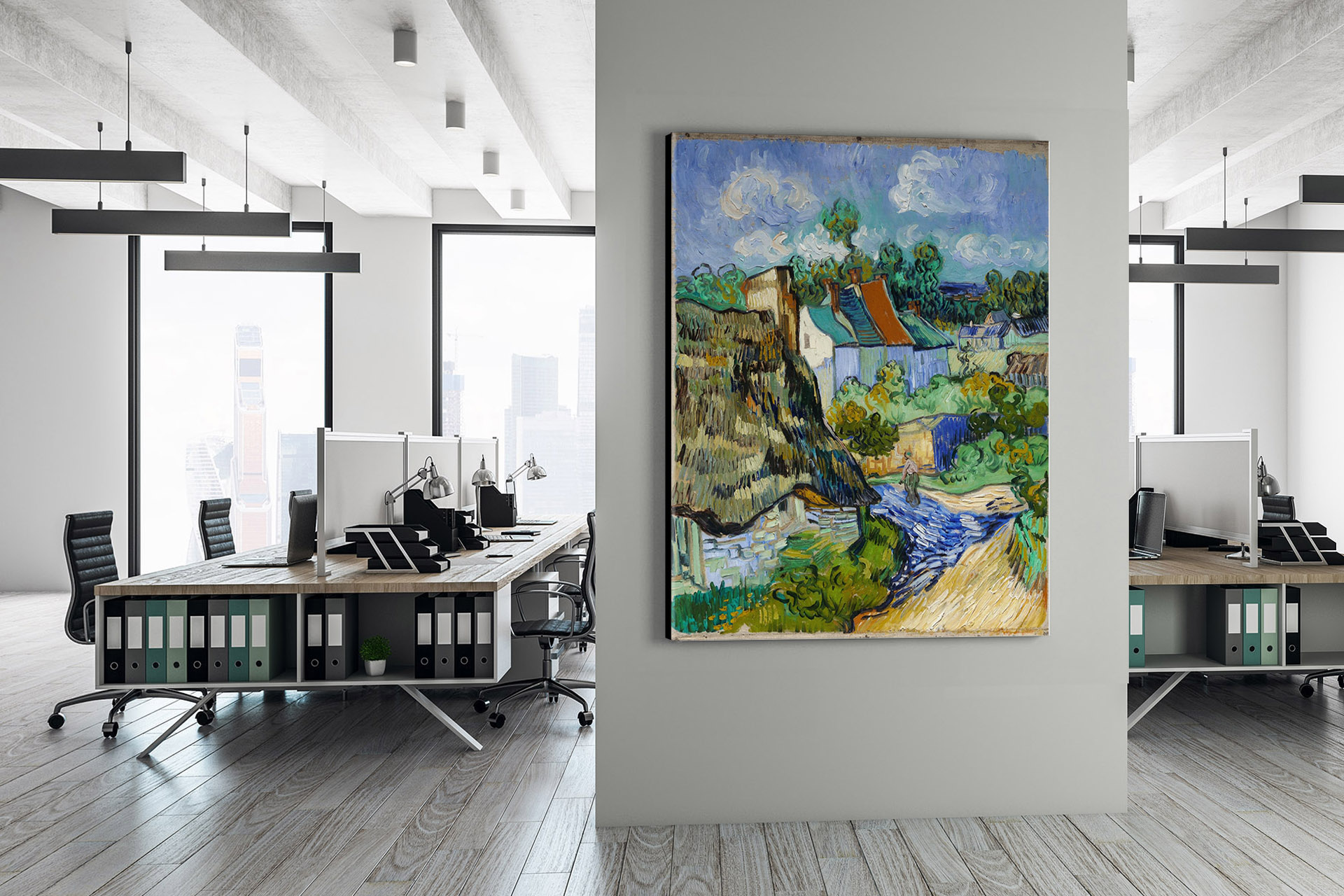Houses at Auvers
By Vincent van Gogh, 1890
Vincent van Gogh’s “Houses at Auvers”: A Masterpiece of Tranquility and Torment
Vincent van Gogh, a name synonymous with artistic brilliance and emotional intensity, bequeathed to the world a prolific body of work that continues to enthrall and mystify art enthusiasts. Within this rich tapestry of creativity, “Houses at Auvers” shines as a crowning jewel, a confirmation to the artist’s genius and the tumultuous life he led. Painted during the summer of 1890, this masterpiece offers not only a glimpse into Van Gogh’s evolving artistic style but also an intimate view of his emotional landscape. Let us embark on a comprehensive exploration of this enigmatic work, situated in the idyllic village of Auvers-sur-Oise.
Auvers-sur-Oise: A Retreat for Van Gogh
In the spring of 1890, Vincent van Gogh found himself seeking solace and artistic inspiration far from the hustle and bustle of city life. His journey led him to the tranquil village of Auvers-sur-Oise, nestled within the breathtaking landscapes of rural France. Surrounded by lush fields, meandering rivers, and charming cottages, Auvers provided the artist with the perfect setting to heal both his troubled mind and creative spirit.
“Houses at Auvers” Large Canvas Prints from WhiteClouds
The Composition Unveiled
“Houses at Auvers” captures the essence of Van Gogh’s post-Impressionist style. Through bold and swirling brushstrokes, he breathed life into the canvas, weaving an intricate tapestry of colors and emotions. The focal point of the composition is a cluster of houses, their thatched roofs and rustic facades bathed in warm, inviting tones. These dwellings, ensconced within the embrace of nature, embody a sense of timeless tranquility. Van Gogh’s keen eye for detail is evident in the meticulous rendering of architectural elements, lending the scene a vivid realism.
Technical Challenges: Van Gogh’s Triumph
Creating “Houses at Auvers” was not without its technical challenges. Van Gogh’s style, characterized by thick impasto brushwork, required him to master the art of applying paint in thick, textured layers. This technique allowed him to convey depth and emotion, but it also posed a challenge in terms of color blending and precision. His use of vibrant, contrasting colors, especially evident in the swirling sky, demanded a deft hand and an acute sense of color theory. Yet, Van Gogh’s commitment to his artistic vision triumphed over these challenges, resulting in a mesmerizing portrayal of the scene.
Emotional Resonance
Van Gogh’s art was never just a mirror reflecting the physical world; it was a window into his own tumultuous soul. “Houses at Auvers” bears the marks of his emotional turbulence, captured on canvas. The frenetic brushwork and vibrant colors convey a sense of restlessness and intensity, mirroring the artist’s inner turmoil. It’s as if he sought to transmute the tempest within his own mind into the tumultuous sky above Auvers.
In his poignant letters to his brother Theo, Van Gogh alluded to his quest to encapsulate the “great sadness of the countryside.” This sentiment reverberates within “Houses at Auvers.” While the village’s exterior exudes a serene charm, beneath the surface lies an undercurrent of melancholy. The swirling sky and the perceived isolation of the houses hint at the artist’s personal struggles and profound sense of solitude.
The Location: Auvers-sur-Oise
Auvers-sur-Oise, a scenic village located in the Val-d’Oise department of France, became a sanctuary for Van Gogh during his final months. Its picturesque landscapes and rustic architecture served as the backdrop for many of his most iconic works, including “Houses at Auvers.” The village’s charm, coupled with its proximity to Paris, made it an ideal destination for artists seeking respite and creative inspiration.
The Painter: Vincent van Gogh
Vincent van Gogh’s life was a testament to the complex interplay between creativity and mental health. Born in the Netherlands in 1853, he embarked on his artistic journey at a relatively late age, initially pursuing a career in various professions before dedicating himself to art. Van Gogh’s style evolved over the years, with periods of experimentation and transformation. His post-Impressionist style, characterized by bold colors and dramatic brushwork, is celebrated for its emotional depth and unique perspective.
Despite facing numerous personal and emotional challenges, including bouts of mental illness, Van Gogh continued to create art with unwavering dedication. His prolific output during his short life left an indelible mark on the art world. Tragically, he passed away in 1890 at the age of 37, having achieved only limited recognition during his lifetime. However, in the years that followed, his work gained the admiration and acclaim it deserved, solidifying his status as one of the most influential artists in history.
Legacy and Endurance
Vincent van Gogh’s “Houses at Auvers” endures as an artistic treasure, a symbol of his unwavering dedication to his craft and his relentless pursuit of emotional expression. It stands as a poignant reminder of the artist’s ability to channel his innermost struggles into art that resonates deeply with viewers.
Today, “Houses at Auvers” occupies a place of honor among Van Gogh’s oeuvre. It serves as a testament to his enduring legacy, capturing not only the charm of a French village but also the depth of human emotion. This painting is a timeless reminder of the power of art to communicate the complexities of the human experience.
 Houses at Auvers by Vincent van Gogh
Houses at Auvers by Vincent van Gogh
Conclusion
Vincent van Gogh’s “Houses at Auvers” is a masterpiece that transcends both time and place. It beautifully encapsulates the tranquility of a picturesque French village and, at the same time, the inner turmoil of its creator. With its dynamic composition, vibrant colors, and emotional depth, this painting continues to inspire and move audiences worldwide. It stands as an enduring confirmation to the profound capacity of art to convey the depths of the human soul, inviting us to embark on a journey into the heart and mind of a tormented genius.
Frequently Asked Questions About “Houses at Auvers “
“Houses at Auvers” by Vincent van Gogh is a renowned work of art that has sparked the curiosity of art enthusiasts and scholars alike. Here are some frequently asked questions about this masterpiece:
What is the significance of “Houses at Auvers” in Vincent van Gogh’s body of work? “Houses at Auvers” holds a special place in Van Gogh’s body of work as one of his final and most iconic pieces. It represents a culmination of his post-Impressionist style and his ability to convey deep emotions through bold brushwork and vibrant colors.
Can you provide some background information about the village of Auvers-sur-Oise and its role in Van Gogh’s life and art? Auvers-sur-Oise was a picturesque village where Van Gogh spent the last few months of his life. The village’s beauty and tranquility served as a rich source of inspiration for many of his works, including “Houses at Auvers.”
What technical challenges did Van Gogh face while creating “Houses at Auvers,” and how did he overcome them? Van Gogh faced the challenge of applying thick impasto brushwork and using contrasting, vibrant colors. He overcame these challenges with determination and skill, resulting in the masterpiece we see today.
What emotions and themes does “Houses at Auvers” convey, and how do they reflect Van Gogh’s state of mind at the time? “Houses at Auvers” conveys a sense of both tranquility and turmoil. The swirling sky and bold brushwork reflect Van Gogh’s inner struggles and emotional intensity during his time in Auvers.
What is the composition of “Houses at Auvers,” and how does Van Gogh use color and brushwork to convey his message? The composition centers on rustic houses set against a swirling sky. Van Gogh uses bold, contrasting colors and thick brushwork to infuse the scene with energy and emotion.
How does the location of the painting, Auvers-sur-Oise, influence the composition and atmosphere of the artwork? The serene beauty of Auvers-sur-Oise is evident in the tranquil houses and natural surroundings depicted in the painting, providing a stark contrast to the tumultuous sky.
Can you provide some insight into the historical context of the painting, including the year it was created and the events in Van Gogh’s life at that time? “Houses at Auvers” was painted in the summer of 1890, a few months before Van Gogh’s tragic death. During this time, he was grappling with mental health issues and sought refuge in Auvers.
What is the current location or museum where “Houses at Auvers” is displayed? “Houses at Auvers” is part of the permanent collection at the Musée d’Orsay in Paris, France, where it can be viewed by visitors from around the world.
How has the critical and public reception of “Houses at Auvers” evolved over the years? Over the years, “Houses at Auvers” has garnered increasing recognition and admiration, cementing its status as an iconic work of art.
Are there any notable artistic influences or inspirations that can be identified in “Houses at Auvers”? Van Gogh’s work was influenced by various artists, including the Impressionists and Post-Impressionists, but he developed a distinctive style that was uniquely his own.
Can you discuss the symbolism or hidden meanings within the painting, if any? While there is no definitive symbolism, the swirling sky and contrast between the houses and the sky may be interpreted as a representation of Van Gogh’s inner turmoil.
How did Van Gogh’s personal struggles and mental health issues impact his artistic output, particularly in the case of “Houses at Auvers”? Van Gogh’s mental health challenges were a constant backdrop to his work. “Houses at Auvers” reflects his ability to channel his emotions into his art, providing an outlet for his inner turmoil.
What is the cultural and artistic significance of “Houses at Auvers” in the broader context of art history? “Houses at Auvers” is a testament to Van Gogh’s artistic evolution and his ability to convey profound emotions through his unique style. It also represents a crucial period in the development of modern art.
Are there any interesting anecdotes or stories related to the creation or interpretation of this painting? While there are no specific anecdotes related to “Houses at Auvers,” Van Gogh’s life and art are filled with fascinating stories, including his friendship with other artists and his correspondence with his brother, Theo.
What role did Vincent’s brother, Theo van Gogh, play in his life and art, and how does it relate to “Houses at Auvers”? Theo played a crucial role in Vincent’s life, providing emotional and financial support. Their correspondence provides insight into Vincent’s thoughts and artistic development during his time in Auvers, including the creation of “Houses at Auvers.”
These frequently asked questions provide a starting point for exploring the intricacies and significance of “Houses at Auvers” by Vincent van Gogh, a painting that continues to captivate and inspire art enthusiasts around the world.
Other Articles on Vincent van Gogh Paintings
At Eternities Gate by Vincent Van Gogh, 1890
Blossoming Almond Tree by Vincent Van Gogh, 1890
Cafe Terrace at Night by Vincent Van Gogh, 1888
Daubigneys Garden by Vincent Van Gogh, 1890
Green Wheat Field with Cypress by Vincent Van Gogh, 1889
Houses at Auvers by Vincent Van Gogh, 1890
Irises by Vincent Van Gogh, 1889
Night Café by Vincent Van Gogh, 1888
Portrait of Dr. Gachet by Vincent Van Gogh, 1890
Red Vineyards by Vincent Van Gogh, 1888
Road with Cypress and Star by Vincent Van Gogh, 1890
Starry Night by Vincent Van Gogh, 1889
Starry Night over the Rhone by Vincent Van Gogh, 1888
Sunflowers by Vincent Van Gogh, 1887
The Bedroom by Vincent Van Gogh, 1888
The Church at Aurers by Vincent Van Gogh, 1890
The Garden of the Asylum by Vincent Van Gogh, 1889
The Mulberry Tree by Vincent Van Gogh, 1889
The Potato Eaters by Vincent Van Gogh, 1885
The Yellow House by Vincent Van Gogh, 1888
Tree Roots by Vincent Van Gogh, 1890
Van Gogh Self Portrait by Vincent Van Gogh, 1887
Vase with Red Poppies by Vincent Van Gogh, 1886
View of Arles by Vincent Van Gogh, 1889
Wheat Field with Crows by Vincent Van Gogh, 1890
Wheat Field with Cypresses by Vincent Van Gogh, 1889
More WhiteClouds Videos
Contact us today to learn more about our 3D services and how we can help you achieve your goals.

